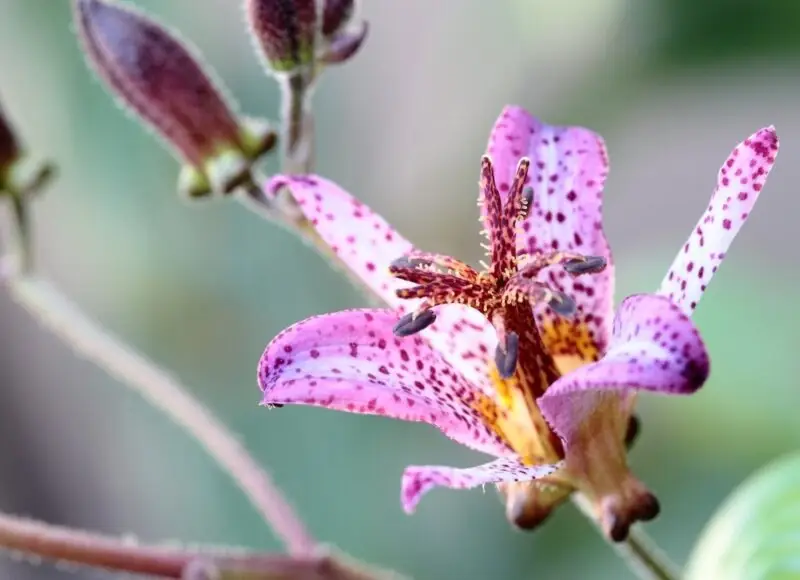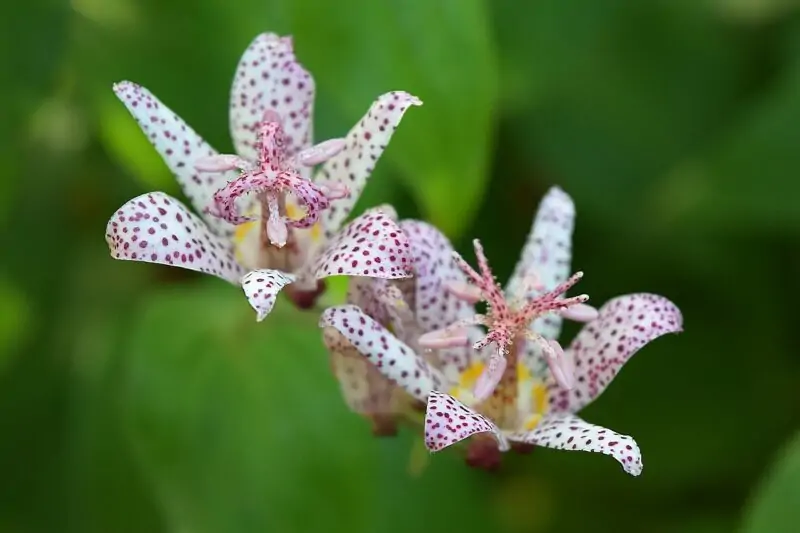Toad Lily Plant: Growing and Caring for Tricyrtis Hirta Flowers

Hey there, fellow garden enthusiasts! Let’s unveil the mystery behind the peculiarly named, yet delightful perennial flower, the toad lily plant. Its scientific name is Tricyrtis, and this charmer, despite its weird name, graces your garden year after year. What makes it a seasonal superstar? These plants grow right from late summer through early fall when most blooms have called it a day. These purple flowers make excellent an excellent addition to any garden, or as a cut flower decor gift. Let’s see why these easy to care for flowers appear on so many gardeners’ wishlists.
Detailed Look at the Toad Lily Plant
The Beauty of Toad Lily Flowers
The flowers are nothing short of spectacular. Resembling orchids, they make any shady corner come alive with their sheer elegance. They typically display a mix of white with dark purple hues and often are spotted with dark purple marks. But there’s more to these beauties. Some varieties offer a mesmerizing blend of purple and white speckled flowers.
Their blooming season adds another level of charm. Unfurling from late summer to early fall, they grow on arching stems arranged in eye-catching clusters. Each flower, with its individual tepal or petal, sports a creamy white base, carefully speckled with dark purple spots. A clump of these flowers can brighten up anyone’s day.
Plant Detail: Understanding the Growth and Structure of Tricyrtis
Let’s look beyond the flowers to appreciate the full charm of the toad lily plant. The stems carry elegance in their arching form, with leaves clasping the base of the plant. The foliage, or leaves, provide a verdant backdrop, setting off the vibrance of the flowers.
In the toad lily family, one particular member stands out – the Tricyrtis hirta, also known as the hairy toad lily, and even the Japanese toad lily. True to its name, this variant features a stem with a fuzzy texture. Adapted to less sunny spots, this shade garden loving variety offers a resilient and captivating choice for areas with partial shade.
Unique Characteristics of These Lavender Flowers
This tall plant knows how to make an impression. It rises tall, its leaves clasping the stem, creating a distinct look. Of particular interest are the sweet spots, nectaries at the base of the tepals. These features add to the allure of this variety. However, the dazzling purple and white flowers, adorned with spots, are the true head-turners.
Cultivars of Toad Lily

Common Toad Lily: Features and Differences
The common toad lily, also known as Tricyrtis hirta, is widely appreciated for its beautiful white flowers. These blossoms bear dark purple spots, offering a captivating contrast. This plant is tough, able to withstand diverse weather conditions, making it suitable for a wide range of garden environments. Furthermore, it’s resilient to the Tricyrtis floral virus, a disease that’s spread by aphids. Vigor and flower quality, what more can a horticulturist ask for?
Tricyrtis Formosana: A Unique Cultivar
Now, meet Tricyrtis formosana, another stunning cultivar. This variant offers flowers that range from white to light lavender. It’s native to the Japanese islands of Honshu and prefers to bask in morning sunlight followed by afternoon shade. It loves moisture and thrives when its soil is consistently damp.
Tricyrtis ‘Tojen’: A Non-Spotted Variety
Introducing ‘Tojen,’ a unique toad lily variant. This cultivar breaks away from the norm with its creamy white flowers devoid of any spots. It’s perfect for anyone seeking subtlety without compromising on beauty. Despite its simple presentation, it’s every bit as charming as its more flamboyant siblings.
Tricyrtis ‘Gilt Edge’: Variegated Foliage
Say hello to ‘Gilt Edge,’ a cultivar of toad lily that prides itself on its leaves as much as its flowers. This variety features green foliage adorned with yellow edges, adding an extra layer of beauty to the plant. Despite the showy foliage, it doesn’t shy away from producing lovely clusters of purple and white speckled flowers.
Tricyrtis ‘Empress’: A Showstopper Cultivar
Last, but not least, meet the ‘Empress,’ a showstopper in its own right. She flaunts clusters of stunning dark purple and white-speckled flowers. Even after other garden plants have ended their blooming cycle, the ‘Empress’ continues to reign supreme, adorning the garden with her magnificent blossoms into the early fall.
Growing and Maintaining a Toad Lily
Guidelines for Planting and Nurturing
Growing these dark purple and white beauties isn’t rocket science. They love shady spots, and the plants will grow and thrive when planted in areas that receive morning sun followed by afternoon shade. You don’t need to be a professional gardener to ensure they grow healthy and tall. Just keep their soil is kept moist, as they don’t do well in dry conditions.
Ensuring Healthy Growth
First, these plants prefer soils that stay moist. Second, they’re not big fans of full sun and prefer partial to full shade. Make sure to water them regularly and keep an eye out for any signs of fungal disease, like orange spots. It’s also crucial to cut off any affected parts of the plant to prevent the disease from spreading.
The Companions
The Astilbe: A Beautiful Garden Combination
Pairing your toad lily with astilbe can result in a stunning garden display. Astilbe is a perennial that also enjoys a moist, shady location. Their feathery blooms, combined with the exotic toad lily flowers, can create a textural feast for the eyes.
Hostas: A Shade-Loving Duo
How about combining two shade-loving plants together? Hostas and toad lilies can coexist beautifully, offering different shapes and sizes of foliage for an aesthetically pleasing contrast. Both can perform well in deep shade, adding a lush look to the darker corners of your garden.
Ferns: Companions for Woodland Gardens
Ferns and toad lilies make great companions for woodland gardens. Both enjoy similar climates and look beautiful when combined. Ferns’ intricate leaves provide a lovely backdrop for the orchid-like flowers of purple and white spotted blooms.
FAQs
Do you have burning questions? We’re here to help.
Like any other blooms, these plants can also have a few hiccups along the way. Fungal disease, spread by aphids, can cause orange spots on the foliage. But don’t fret! Just remove the affected parts of the plant, and your toad lily will be back on its journey toward vigorous growth and flower quality.
Toad Lilies are generally considered non-toxic to both pets and humans. That doesn’t mean you should start making tea from the flowers. They’re more suited as a feast for the eyes. Eating a lot of them can cause stomach discomfort.
Toad lilies are best when fertilized during the spring and mid-summer for optimal growth and blooming. Avoid fertilizing in late summer or fall for the best flower buds.
Conclusion
In wrapping up our green journey, it’s clear the toad lily plant is truly a gem. It lights up your garden’s shady nooks with its unique, orchid-like flowers. It’s not only diverse, boasting an array of impressive cultivars, but it also plays well with others, partnering beautifully with hosta, astilbe, and ferns. So, if you’re after a hardy and striking perennial that can bring life to your garden during late summer and early fall, the toad lily plant is a top contender. Happy gardening!